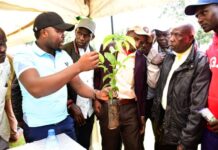By Zablon Oyugi
In the wake of dire climate change effects globally and dwindled crop harvest leading to food insecurity, biostimulants application are now being considered as sustainable tool for plant production and a meaningful approach to plants nutrition boost thus reducing the gap between organic and conventional yields.
According to a 2018 review on Plant Biostimulants: Innovative Tool for Enhancing Plant Nutrition in Organic Farming published by European Journal of Horticultural Science, biostimulants application can overcome nutrient limitation typical of organic systems by improving nutrient availability, uptake and assimilation, and consequently reducing the gap between organic and conventional yields.
In fact, given the increasing interest worldwide in organically produced foods in the past two decades and the need for environmentally-friendly production system able to produce food with minimal harm to ecosystems as well as minimal use of off-farm inputs, the use of naturally derived plant biostimulants continues to offer some ray of hope for farmers and consumers.
Cathy Liu, the Marketing Director at Wellyou Tech, a Chinese-based supplier of agricultural chemicals says plant biostimulant substances come from various natural sources such as plant extracts, hormones, seaweed and other organic materials best for crops yields enhancement.
“These substances contain compounds that activate or enhance certain physiological processes in plants, thereby increasing yield, quality and stress resistance thus helping in plant growth and development,” said Liu in her LinkedIn published piece on Application of plant biostimulant in agriculture.
Types of plant biostimulants
Plant biostimulants encompass various categories, such as humic and fulvic acids, amino acids, seaweed extracts, and plant growth regulators like auxins, cytokinins, and gibberellins. Each category offers distinct advantages tailored to different crops and growth phases.
The classification is based on their action in the plants or, on the physiological plant responses rather than on their composition.
A significant use of plant biostimulants in agriculture is mitigating plant stress induced by diverse environmental factors.
Climate change effects such as drought, salinity, and fluctuations in temperature are among the stressors impacting plant health, consequently influencing crop yield and quality.
However, biostimulants are able to stimulate the natural processes in plants when they need it the most allowing plants to achieve optimal yields in situations where the environmental conditions are not ideal, enabling farmers to be both profitable and sustainable, according to Yara International ASA document on Plant Biostimulants: a vital solution for sustainable agriculture and a resilient food system.
How biostimulants can enable farmers achieve sustainable agriculture
When used alongside organic and mineral fertilizers, biostimulants can significantly benefit farmers striving to embrace climate-positive practices, address food loss and waste, and maintain the profitability of their farms.
According to Yara, the following are some of the ways this can be achieved:
Enhancing nutrient utilization: Biostimulants enhance nutrient utilization by promoting robust root development, enabling plants to absorb increased amounts of nutrients and water, or by enhancing nutrient availability within the soil.
These functionalities collectively aid in minimizing nutrient wastage into the environment and optimizing fertilizer utilization.
Indeed, several studies conducted on greenhouse and open-field vegetables suggest that applications of biostimulant substances can promote nutrient uptake and assimilation as their appropriate application can improve root and shoot vigor.
In addition, the increase of plant nutrient uptake has been often attributed to one or more of the following factors: an increase in soil enzymatic and microbial activities, modification of root architecture as well as an enhancement in mi-cronutrient mobility and solubility, according to the European Journal of Horticultural Science publication.
Soil health: Soil has humic substances (HS) which are natural substances resulting from the chemical and biological transformations of dead cell materials as well as from microbial metabolism.
HS have been recognized as essential contributors on the physico-chemical properties of soils thus most biostimulant effects of HS refer to stimulation of root growth and improvement of plant nutrition resulting from the increase of soil nutrient availability.
Certain biostimulants have the capability to enhance soil health and fertility by enriching soil parameters and functions.
This can additionally foster positive outcomes in terms of soil restoration and water utilization efficiency, crucially contributing to the long-term preservation of soil fertility.
Resistance/tolerance to climate change: Biostimulants have the potential to bolster plants’ resilience against abiotic stressors like drought or extreme temperatures.
Consequently, integrating biostimulants into agricultural practices can aid in alleviating the adverse effects of climate change and extreme weather occurrences.
Such measures are crucial for farmers who must continually adjust their methods to contend with evolving and demanding climatic conditions.
In fact, the stress protection of bacterial biostimulants to rain-fed field crops can be of particular relevance under increasing temperatures foreseen by most prediction models of climate change.
For abiotic stress that has been becoming a major threat to food security due to the constant changes in climate, biostimulants have been highlighted as a promoter of optimizing productivity by modifying physiological processes in plants.
Crop quality: Biostimulants have the potential to enhance crop quality, fostering the growth of robust and healthy plants, ultimately reducing food wastage.
Concurrently, they can augment both the quality and quantity of yields, thereby supporting the profitability and sustainability of the farmer’s enterprise.
Addressing food loss and waste stands as a pivotal component in establishing a sustainable food system.
Biostimulants as complementary to fertilizers
Generally, biostimulants are complementary to fertilizers, in that, while fertilizers are food for plants, biostimulants are like vitamins for plants.
“Biostimulants should therefore be considered as one of the solutions in an integrated crop management toolkit focusing on sustainability along with fertilizers, biologicals, plant protection products, and digital tools,’ says Yara.
However, the selection of the appropriate biostimulant is critical as the effects can vary markedly between species.
In addition, there is a need to address the underlying mechanisms responsible for these effects, given the large number of substances that can be used as biostimulant raw material, such as humic substances, seaweed extracts, plant hormones, and plant growth-promoting rhizobacteria.









